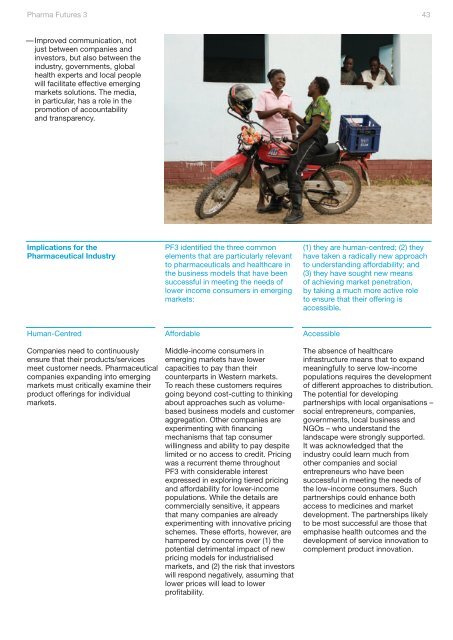Pharma Futures 3 Emerging Opportunities
Pharma Futures 3 Emerging Opportunities
Pharma Futures 3 Emerging Opportunities
You also want an ePaper? Increase the reach of your titles
YUMPU automatically turns print PDFs into web optimized ePapers that Google loves.
<strong>Pharma</strong> <strong>Futures</strong> 3<br />
— Improved communication, not<br />
just between companies and<br />
investors, but also between the<br />
industry, governments, global<br />
health experts and local people<br />
will facilitate effective emerging<br />
markets solutions. The media,<br />
in particular, has a role in the<br />
promotion of accountability<br />
and transparency.<br />
Implications for the<br />
<strong>Pharma</strong>ceutical Industry<br />
Human-Centred<br />
Companies need to continuously<br />
ensure that their products/services<br />
meet customer needs. <strong>Pharma</strong>ceutical<br />
companies expanding into emerging<br />
markets must critically examine their<br />
product offerings for individual<br />
markets.<br />
PF3 identified the three common<br />
elements that are particularly relevant<br />
to pharmaceuticals and healthcare in<br />
the business models that have been<br />
successful in meeting the needs of<br />
lower income consumers in emerging<br />
markets:<br />
Affordable<br />
Middle-income consumers in<br />
emerging markets have lower<br />
capacities to pay than their<br />
counterparts in Western markets.<br />
To reach these customers requires<br />
going beyond cost-cutting to thinking<br />
about approaches such as volumebased<br />
business models and customer<br />
aggregation. Other companies are<br />
experimenting with financing<br />
mechanisms that tap consumer<br />
willingness and ability to pay despite<br />
limited or no access to credit. Pricing<br />
was a recurrent theme throughout<br />
PF3 with considerable interest<br />
expressed in exploring tiered pricing<br />
and affordability for lower-income<br />
populations. While the details are<br />
commercially sensitive, it appears<br />
that many companies are already<br />
experimenting with innovative pricing<br />
schemes. These efforts, however, are<br />
hampered by concerns over (1) the<br />
potential detrimental impact of new<br />
pricing models for industrialised<br />
markets, and (2) the risk that investors<br />
will respond negatively, assuming that<br />
lower prices will lead to lower<br />
profitability.<br />
43<br />
(1) they are human-centred; (2) they<br />
have taken a radically new approach<br />
to understanding affordability; and<br />
(3) they have sought new means<br />
of achieving market penetration,<br />
by taking a much more active role<br />
to ensure that their offering is<br />
accessible.<br />
Accessible<br />
The absence of healthcare<br />
infrastructure means that to expand<br />
meaningfully to serve low-income<br />
populations requires the development<br />
of different approaches to distribution.<br />
The potential for developing<br />
partnerships with local organisations –<br />
social entrepreneurs, companies,<br />
governments, local business and<br />
NGOs – who understand the<br />
landscape were strongly supported.<br />
It was acknowledged that the<br />
industry could learn much from<br />
other companies and social<br />
entrepreneurs who have been<br />
successful in meeting the needs of<br />
the low-income consumers. Such<br />
partnerships could enhance both<br />
access to medicines and market<br />
development. The partnerships likely<br />
to be most successful are those that<br />
emphasise health outcomes and the<br />
development of service innovation to<br />
complement product innovation.



